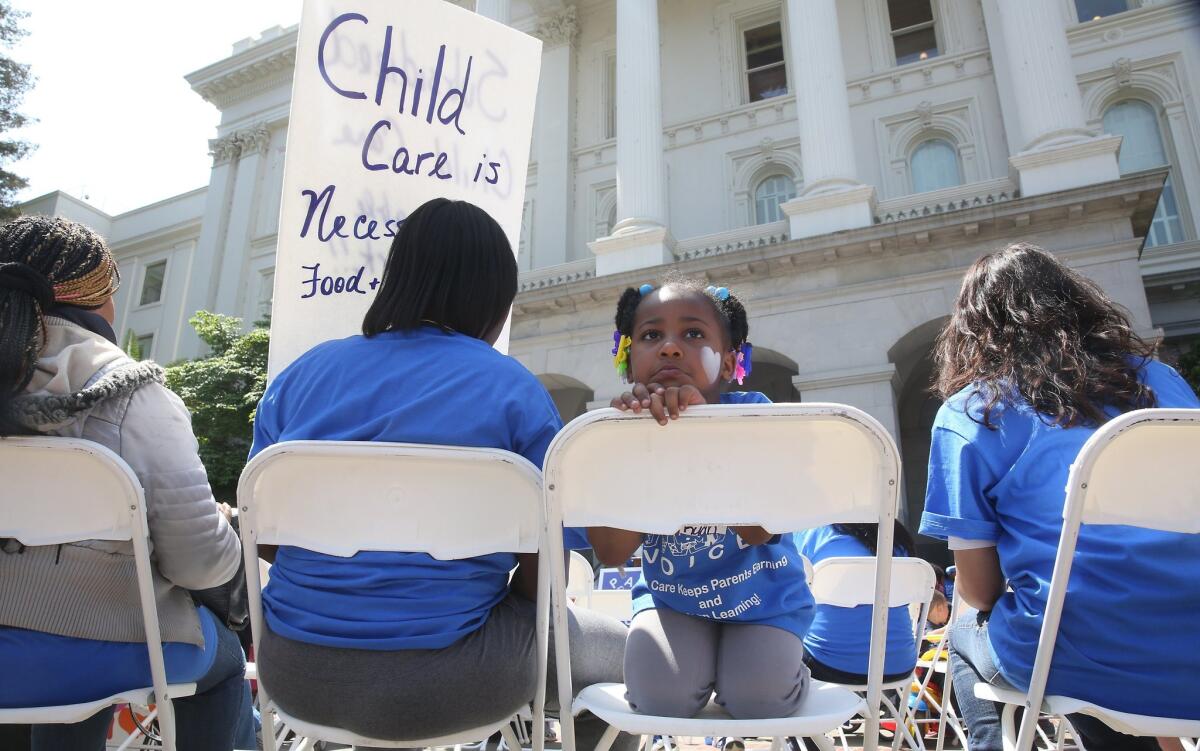Op-Ed: Preschool for all is no panacea, California

A young girl sits with her mother at a rally calling for increased child care subsidies at the Capitol in Sacramento on May 6.
- Share via
After passing with strong bipartisan support in the Assembly and the state Senate, AB 47, the Preschool for All Act of 2015, is on Gov. Jerry Brown’s desk awaiting his signature. The bill would ensure that by June 30, 2018, all of California’s economically disadvantaged 4-year-olds would have access to the state preschool program, contingent on the appropriation of sufficient funding in the annual budget.
Providing access to preschool for the state’s low-income children may sound like an obviously good idea. Indeed, we know that the first five years are the most critical period for human learning and development. Early childhood programs that help disadvantaged infants, toddlers and preschoolers get a decent start can make a big difference in ensuring that all children have a chance to succeed in school and in life. But the Preschool for All Act is the wrong way to give kids a boost.
In the first place, California public schools have a dismal track record with disadvantaged children, who are the intended targets of the bill. After five years in school, just 16% of Latino children, 13% of African American children and 15% of low-income children are proficient in reading. In eighth grade, only 18% of Latino children, 15% of African American children and 17% of low-income children have reached proficiency. Only 76% of Latinos and 68% of African Americans graduate from high school.
Why should the California public schools be expected to do any better with a new grade than they’ve done with the 13 already in place?
California should also heed the results of the first rigorous investigation of a statewide pre-K program, released last week by Vanderbilt University. In a multiyear study of Tennessee’s program — widely recognized as one of the highest-quality state pre-K programs in the nation — researchers Dale Farran and Mark Lipsey found that economically disadvantaged children who attended the program did worse by the third grade on most academic and behavioral measures than those who did not.
While pre-K advocates are disappointed by the results of the Vanderbilt study, they shouldn’t be surprised. Maintaining high quality in large-scale, state pre-K programs is very hard to do, and pre-K is already too little, too late for many children.
Crucial brain development occurs long before children turn 4. Gaps between advantaged and disadvantaged children begin emerging as early as 9 months of age. By 18 months, toddlers in low-income families can already be several months behind in language development. By age 3, children with college-educated parents have vocabularies as much as three times larger than those whose parents did not complete high school.
Beginning at birth, children rapidly and continuously learn from whomever they’re with, wherever they are, which is largely at home and in child care. Their healthy development depends entirely on the quality of those environments, because what really matters are children’s hour-to-hour, day-to-day experiences starting in the first months of life. If we really want to help kids, we have to improve the quality of home environments and child care, not just increase the number of 4-year-olds attending public school.
Parents are their children’s first and most powerful teachers. Public information campaigns can help parents understand the vital role they play in developing their children’s brains. Voluntary home visiting programs for at-risk infants and toddlers can shore up fragile families and make a positive difference both in the self-sufficiency of parents and in the children’s later academic and social outcomes.
Outside of the home, child care is the most important early learning program. All too often, however, there’s zero quality control. In California, 1.8 million infants, toddlers and preschoolers have working parents and are in child care for thousands of hours before they turn 4. But only 3% of the million available spaces in California’s child-care centers and family homes are nationally accredited. Hundreds of thousands of additional children are in “informal” care — with aunts, neighbors, older siblings — all day, every day, during the most critical developmental period of their lives.
The quality of child care matters tremendously. A recently released study of an inexpensive, large-scale child-care program that Quebec instituted in the 1990s, for example, found “striking evidence” that teenagers who had attended as young children were worse off later in life than those who had not. They were more likely to commit crimes, have worse health and attest lower levels of life satisfaction.
While this is just one study, common sense suggests that the settings where infants, toddlers and preschoolers spend many of their waking hours have a significant impact on their development.
Instead of launching a costly and unproven program for 4-year-olds, California should invest in helping vulnerable, young children where they are during the first 35,000 hours of their lives: in the home and in child care.
Katharine B. Stevens is a research fellow in education policy studies at the American Enterprise Institute.
Follow the Opinion section on Twitter @latimesopinion and Facebook
More to Read
A cure for the common opinion
Get thought-provoking perspectives with our weekly newsletter.
You may occasionally receive promotional content from the Los Angeles Times.










